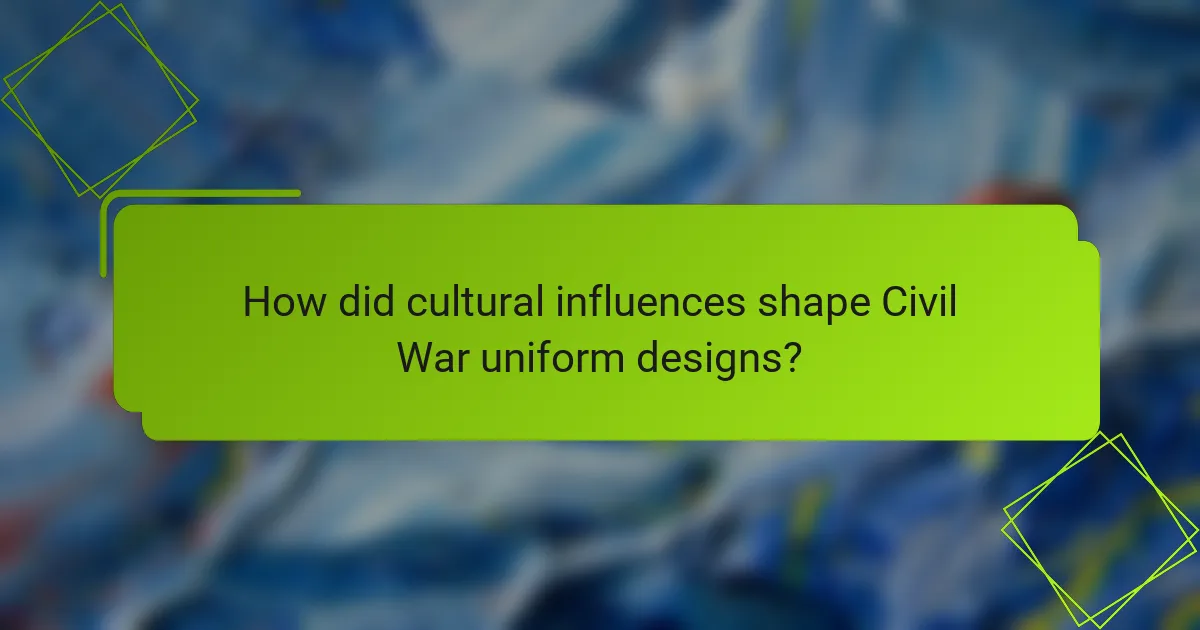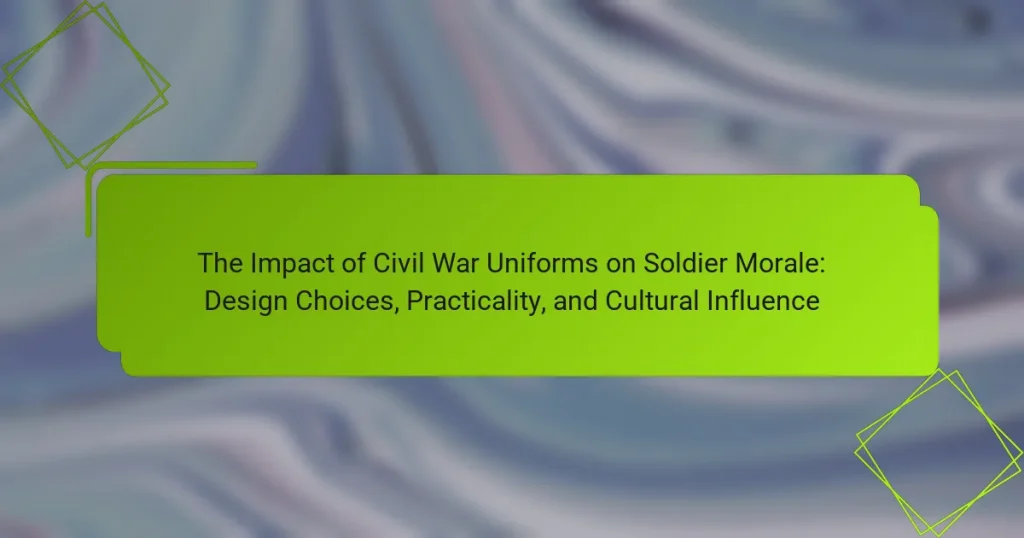The article examines the impact of Civil War uniforms on soldier morale, highlighting how design choices, practicality, and cultural influences shaped the experience of soldiers. Civil War uniforms fostered a sense of identity and unity among troops, enhancing recognition and loyalty within regiments. The distinct colors and styles of uniforms, influenced by regional heritage and European military traditions, contributed to soldiers’ pride and psychological well-being. Additionally, the article discusses how practical considerations, such as comfort and functionality, played a role in soldiers’ performance and perceptions during battles. Overall, the significance of uniform design in promoting morale and fostering a sense of belonging is emphasized throughout the discussion.

What is the significance of Civil War uniforms on soldier morale?
Civil War uniforms significantly impacted soldier morale by fostering a sense of identity and unity. The distinct colors and designs of uniforms helped soldiers recognize their comrades and establish loyalty to their regiment. Uniforms also provided a psychological boost, instilling pride and a sense of purpose. Soldiers in well-designed uniforms often felt more professional and disciplined. Historical records indicate that troops with cohesive uniforms displayed higher morale during battles. Additionally, the visibility of uniforms contributed to a sense of belonging to a larger cause. Overall, the significance of Civil War uniforms on soldier morale was profound and multi-faceted.
How did design choices in Civil War uniforms affect soldiers’ feelings?
Design choices in Civil War uniforms significantly influenced soldiers’ feelings of pride and identity. The colors and styles of the uniforms were often symbolic, fostering a sense of belonging to a specific side. For instance, Union soldiers wore blue, which represented loyalty and unity, while Confederate soldiers donned gray, symbolizing regional pride. These color choices instilled a sense of purpose and commitment among the troops.
Additionally, the uniform design provided practical benefits that affected morale. Well-fitted and functional uniforms improved comfort and mobility, which positively impacted soldiers’ confidence in battle. Historical records indicate that soldiers who felt comfortable in their attire were more likely to perform better and maintain a positive outlook.
Moreover, the uniforms served as a visual representation of the soldiers’ values and beliefs, enhancing their emotional connection to the cause they fought for. This connection was crucial for maintaining morale during challenging times. Overall, the design choices in Civil War uniforms played a vital role in shaping soldiers’ feelings of pride, identity, and morale.
What specific design elements contributed to a sense of pride among soldiers?
Distinct design elements of Civil War uniforms that contributed to a sense of pride among soldiers included distinctive colors, insignia, and tailored fits. The use of bold colors, such as Union blue and Confederate gray, fostered a strong visual identity. Insignia represented rank and unit affiliation, creating a sense of belonging and honor. Tailored fits enhanced comfort and mobility, which positively affected soldiers’ morale. Additionally, the incorporation of historical motifs and symbols connected soldiers to a larger narrative of patriotism and duty. Historical records show that these design choices played a significant role in boosting soldiers’ confidence and unity during the Civil War.
How did color choices impact soldier identity and morale?
Color choices significantly influenced soldier identity and morale during the Civil War. Distinct colors helped create a sense of belonging among troops. For example, Union soldiers wore blue, while Confederate soldiers donned gray. This color differentiation fostered camaraderie and unity within each faction. Soldiers often felt pride in their uniforms, which represented their cause and identity. Additionally, vibrant colors could boost morale by enhancing visibility and creating a sense of bravery. Historical records indicate that soldiers’ attachment to their uniforms often translated into a stronger commitment to their side. The psychological impact of uniform colors played a crucial role in shaping soldiers’ perceptions of themselves and their mission.
What role did practicality play in the effectiveness of Civil War uniforms?
Practicality was crucial in the effectiveness of Civil War uniforms. Uniforms needed to be functional for various battlefield conditions. They were designed for durability, allowing soldiers to withstand harsh weather. The choice of fabric, often wool, provided warmth and protection. Additionally, practicality included ease of movement for combat scenarios. The color and design helped with identification among troops. This reduced confusion during battles, enhancing unit cohesion. Historical records show that practical uniforms improved soldier morale and performance. Effective uniforms contributed to a soldier’s sense of identity and belonging.
How did the materials used in uniforms influence soldier comfort and performance?
The materials used in uniforms significantly influenced soldier comfort and performance. Wool, cotton, and linen were commonly used fabrics. Wool provided insulation and moisture-wicking properties, keeping soldiers warm and dry. Cotton was lighter and breathable, enhancing comfort in warmer conditions. Linen, while less common, offered a cooling effect in hot weather.
The choice of material affected soldiers’ mobility and endurance. Heavier fabrics could restrict movement, while lighter materials allowed for greater agility. Historical records indicate that soldiers often suffered from heat exhaustion due to inadequate fabric choices.
Moreover, the durability of materials impacted performance over extended campaigns. Uniforms made from robust fabrics withstood wear and tear better, prolonging their usability. In contrast, inferior materials led to quicker degradation, affecting morale and functionality.
In summary, the selection of uniform materials directly correlated with comfort and operational effectiveness during the Civil War.
What were the logistical challenges of uniform production during the Civil War?
Uniform production during the Civil War faced significant logistical challenges. Supplies were often scarce due to disrupted supply lines caused by battles. The rapid mobilization of troops created urgent demands for uniforms. Manufacturers struggled to meet these demands while maintaining quality. Inconsistent materials led to variations in uniform appearance and durability. Additionally, transportation issues complicated the distribution of uniforms to various regiments. The lack of standardized designs further complicated production efforts. These challenges ultimately affected soldiers’ morale and readiness.

How did cultural influences shape Civil War uniform designs?
Cultural influences significantly shaped Civil War uniform designs through symbolism and regional identity. The colors and styles reflected the values and traditions of the states. For instance, the Confederacy often used gray, symbolizing Southern heritage. The Union favored blue, representing loyalty and unity. Additionally, military traditions from Europe influenced the cut and ornamentation of uniforms. Many designs incorporated elements from British and French uniforms, emphasizing professionalism. The use of insignia also conveyed rank and unit affiliation, reinforcing a sense of belonging. Overall, these cultural factors created uniforms that not only served practical purposes but also fostered pride and morale among soldiers.
What cultural symbols were incorporated into Civil War uniforms?
Civil War uniforms incorporated various cultural symbols that reflected regional identities. The Confederate uniforms often featured the Southern Cross, symbolizing the Confederacy. This emblem represented the Southern states’ fight for independence. Union uniforms commonly displayed the eagle, a symbol of national unity and strength. Both sides used colors to signify allegiance; blue for the Union and gray for the Confederacy. Additionally, some units included state insignias, showcasing local pride. These symbols aimed to boost morale and foster a sense of belonging among soldiers. The incorporation of these cultural elements was significant in reinforcing identity during the conflict.
How did regional differences affect uniform styles and soldier morale?
Regional differences significantly influenced uniform styles and soldier morale during the Civil War. The Union and Confederate armies adopted distinct colors and designs that reflected their regional identities. For example, Union soldiers commonly wore blue uniforms, while Confederate soldiers wore gray. This color distinction fostered a sense of belonging and pride among soldiers.
Uniform styles also varied based on local resources and climate. Northern states had access to wool and durable fabrics, resulting in heavier uniforms suitable for colder weather. In contrast, Southern states often used lighter materials due to resource scarcity and warmer conditions. This disparity affected comfort and functionality, impacting soldier morale.
Cultural influences played a role in uniform design. Regional symbols and insignia were incorporated into uniforms, reinforcing local pride. Soldiers often felt more connected to their units when their uniforms reflected their home states. This connection contributed positively to morale, as soldiers fought not just for a cause but also for their regional identity.
Historical records show that soldiers who felt a strong attachment to their uniforms were more likely to display resilience in battle. The psychological impact of wearing a uniform that represented their region was significant. Uniforms served as a visual representation of loyalty and commitment, further influencing overall soldier morale.
What impact did historical precedents have on uniform design choices?
Historical precedents significantly influenced uniform design choices. Uniforms often reflect the military traditions and historical battles of previous eras. For instance, the adoption of specific colors and styles can be traced back to earlier conflicts. The American Civil War saw the use of blue and gray, which were rooted in regional affiliations and historical military uniforms. Additionally, the use of insignias and decorations evolved from historical practices, providing identity and rank recognition. Historical battles also shaped practical design choices, emphasizing functionality based on past experiences in combat. The impact of these precedents is evident in the continued use of certain styles and colors in modern military uniforms.
Why is understanding the impact of uniforms on soldier morale important today?
Understanding the impact of uniforms on soldier morale is crucial today because it influences unit cohesion and effectiveness. Uniforms serve as symbols of identity and belonging, fostering pride among soldiers. This pride can enhance motivation and performance in challenging situations. Historical studies show that well-designed uniforms can improve morale, leading to better outcomes in military engagements. For instance, during the Civil War, uniforms that were comfortable and practical contributed to soldiers’ willingness to fight. Additionally, contemporary military research highlights that uniforms affect perceptions of professionalism and discipline. Thus, recognizing these factors helps military leaders make informed decisions about uniform design and policy.

What lessons can be learned from the Civil War uniform experience?
The Civil War uniform experience teaches important lessons about identity and morale in military settings. Uniforms served as symbols of loyalty and allegiance. Soldiers felt a sense of pride when wearing their respective uniforms. This pride contributed positively to their morale during battles. The design choices reflected cultural values and social status. Practicality in uniform design affected soldiers’ comfort and performance. For instance, wool uniforms provided warmth but were heavy. The color and style of uniforms also influenced perceptions among soldiers and civilians. Overall, the Civil War uniform experience highlights the significance of thoughtful design in fostering unity and boosting soldier morale.
How can modern military attire benefit from historical insights?
Modern military attire can benefit from historical insights by integrating design elements that enhance functionality and morale. Historical uniforms, such as those from the Civil War, were designed with specific purposes in mind. They often prioritized practicality, using durable materials suitable for various weather conditions.
Additionally, historical insights reveal the psychological impact of uniform colors and styles on troop morale. For instance, the use of blue and gray during the Civil War fostered a sense of identity and unity among soldiers. Research indicates that uniforms can significantly affect soldiers’ confidence and group cohesion.
Furthermore, lessons from past military attire can inform contemporary ergonomic designs. Historical analysis of uniform fit and flexibility can lead to improved comfort and movement for modern soldiers. Overall, leveraging historical insights can create uniforms that are not only practical but also boost morale and performance in the field.
What best practices can be derived from Civil War uniform designs for current military uniforms?
Civil War uniform designs offer several best practices for current military uniforms. First, the use of durable fabrics is essential. Civil War uniforms were made from wool and cotton, providing both comfort and resilience. Second, color choices can influence morale. Union blue and Confederate gray fostered a sense of identity. Third, functional design features like pockets and epaulets improved practicality. These elements enhanced soldier utility and organization. Fourth, historical symbolism can boost morale. Incorporating insignia or historical references can create pride. Lastly, adaptability for various climates is crucial. Civil War uniforms were designed for different environments, ensuring soldier comfort and effectiveness.
How can the study of Civil War uniforms inform contemporary discussions on military morale?
The study of Civil War uniforms can inform contemporary discussions on military morale by highlighting the psychological impact of uniform design on soldiers. Civil War uniforms were not only practical but also served to foster a sense of identity and belonging among troops. Research indicates that soldiers often derived morale from the pride associated with their uniforms, which represented their regiment and cause. For example, distinctive colors and insignia helped build camaraderie and unity within units. Additionally, the visibility of uniforms in battle affected soldier behavior; those in well-designed, recognizable uniforms were often more motivated to fight. Historical accounts reveal that soldiers felt a stronger connection to their uniforms, which in turn influenced their morale and performance. Thus, examining these aspects of Civil War uniforms provides valuable insights into how uniform design can affect modern military morale.
What are practical considerations for designing uniforms that enhance soldier morale today?
Practical considerations for designing uniforms that enhance soldier morale today include comfort, functionality, and psychological impact. Comfortable materials reduce fatigue and improve focus. Functional designs allow ease of movement and accessibility to equipment. Psychological factors, such as uniform color and style, can foster a sense of identity and belonging. Research indicates that uniforms reflecting cultural heritage boost pride and morale among soldiers. Additionally, incorporating input from soldiers during the design process can increase buy-in and satisfaction. Overall, these considerations directly contribute to improved morale and operational effectiveness.
The main entity of the article is Civil War uniforms and their impact on soldier morale. The article explores how design choices, practicality, and cultural influences of these uniforms significantly affected soldiers’ feelings of pride, identity, and unity during the Civil War. Key aspects discussed include the psychological effects of color choices, the importance of functional materials, and the logistical challenges of uniform production. Additionally, the article examines how historical precedents and regional differences shaped uniform designs, ultimately influencing soldier performance and morale. Insights drawn from this historical analysis can inform contemporary military uniform design and its effects on soldier morale.




